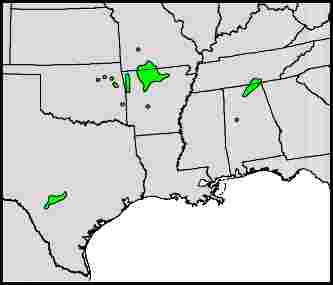American Smoketree
(Cotinus obovatus)
The American Smoketree gets its name from its clusters of tiny blossoms which from a distance look like puffs of smoke. The individual blossoms are greenish-white, but the fuzzy flower stalks, which can be pink or purple, add additional color. The effect is often subtle, and male trees usually put on a somewhat showier display.
The tree typically grows 20 to 30 feet tall, and is often multi-trunked. The flowers on female trees develop into small seeds that are eaten by some finches. The leaves, which are bright green in summer, can turn to a spectacular orange-red before dropping in autumn. Specimens in sunny locations generally have the best color, but genetic variations or soil characteristics may have an influence.
American Smoketree should not be confused with the non-native Common Smoketree (Cotinus coggygria), which is sold in many nurseries and often planted in yards. The American plant, though in some ways more attractive, is much less common in landscapes. It is also very uncommon in the wild, being mostly restricted to isolated stands in an irregular band from Tennessee to Oklahoma and Texas. In cultivation the species has proven to be cold hardy in the north, which suggests that it once grew there. Possibly it migrated toward the south during the ice ages, but still retains its former cold-hardiness.
Despite its rarity, the American Smoketree is easy to grow. It is tough enough to tolerate rocky alkaline soils and long droughts. Young plants in sunny locations can grow rather rapidly, up to two feet a year.
Other Information
Scientific Names: Cotinus obovatus, Cotinus americanus
Common Names: American Smoketree, Chittamwood
Plant Type: Small deciduous tree
Height: 20 to 30 feet
Cultivation Zones: 4 - 8
Native Habitat: Rocky uplands and ravines, openings in hardwood forests
Native Range: Scattered populations in an irregular pattern from Tennessee to south-central Texas. See distribution map below.
Distribution Map

Range Map Source: U.S. Forest Service. (See General Note C)
Conservation Status: NatureServe lists Cotinus obovatus as Critically Imperiled in Georgia, Imperiled in Tennessee and Alabama, and Vulnerable in Oklahoma. Officially the species is put into the category of Special Concern in Tennessee.
Cultivation: Although the American Smoketree can survive harsh conditions and neglect, it grows faster and blooms more profusely in good soil and a sunny exposure. It is more tolerant of alkaline soils than most native species, but may dislike permanently-moist conditions. Do not over-fertilize. Seeds need both warm and cold stratification, and can take up to two years to germinate. Go to Cultivation for more information.
Related Species: There are no other native species in this genus. The common smoketree generally sold in nurseries is an import from Eurasia.
Plant Sources: Look for the American Smoketree at Woodlanders, Nearly Native Nursery, and Forest Farm. Selections with dependably-good fall color include "Jan's Delight" and "Tulsa Lady" (female), but note that they may be sold as grafted plants. For links to the mentioned suppliers, go to Sources of Plants.
|

